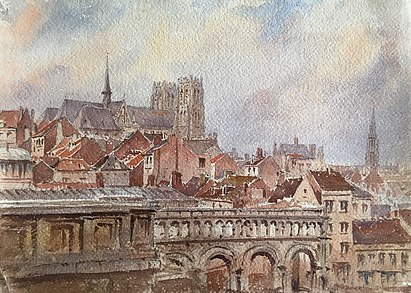John Louis Petit (also known as The Reverend John Louis Petit; 31 May 1801 – 1 December 1868) was an artist and architectural historian whose paintings of buildings and landscapes, almost exclusively in watercolour, complemented his activities as one of the mid-19th century's leading writers and speakers on ecclesiastical architecture. He was a vocal opponent of the dominant architectural orthodoxies of the Gothic Revival.

During extensive travels both at home and in continental Europe (as well as the Middle East), Petit painted buildings of different periods and styles with a particular focus on medieval architecture. His subject matter included landscapes, modern urban views, utilitarian structures such as bridges and factories, and Classical ruins.
His paintings were completed on the spot, and are frequently marked by a sketch-like immediacy that places his work outside the mainstream of 19th century picturesque travel views, calling to mind some aspects of Pre-Impressionism.
In numerous watercolours of ecclesiastical buildings, he conveyed the visual and emotional impact of churches and cathedrals individually and in their settings. Displays of his watercolours at his talks, sometimes a hundred at a time, contributed to his popularity as a speaker.
Born into a prominent and well-to-do family of French Huguenot origins, he was ordained into the Church of England in his mid-twenties, but ceased parochial work a few years later. He never painted for money, and after his death his art disappeared from public view and was largely forgotten, although the impact of his architectural writings lingered into the following century.[1]
A huge cache of his work was held by descendants until the 1980s when it was sold, mainly in regional auctions, in large lots mixed with poorer work by his sisters.
Renewed interest in Petit since 2016 has led to the publication of a number of books and articles, the founding of the Rev. J.L. Petit Society to promote awareness of his artistic and architectural legacy,[2] and the installation of information boards in Lichfield where Petit lived and where he is buried. The chapel he designed in Caerdeon, St Philip's, in northwest Wales, was upgraded to Grade I listing in 2018.[3]
- ^ References to Petit became increasingly cursory and sometimes misleading. For instance, in a study of 19th century writers on architecture, Sir Nikolaus Pevsner referred only to Petit's first book. Nikolaus Pevsner, Some Architectural Writers of the 19th Century. Oxford: Clarendon Press, 1972, p. 95
- ^ "Rev. J L Petit – The Rev. J L Petit Society Website". Retrieved 9 July 2022.
- ^ Cadw. "St Philip's Church, Caerdeon (Grade I) (5249)". National Historic Assets of Wales. Retrieved 20 September 2023.